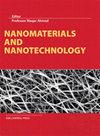Cu-Ni掺杂钼酸铋的合成、表征及环境应用
IF 3.3
3区 材料科学
Q2 MATERIALS SCIENCE, MULTIDISCIPLINARY
引用次数: 0
摘要
铋基催化剂以其低成本、可行性、稳定性、小且带隙可调等优点,在光催化修复环境污染物方面受到关注。在本工作中,通过过渡金属掺杂对钼酸铋进行改性,以实现最大的催化效率。这一目标是通过合成新型Cu2+和Ni2+共掺杂的钼酸铋(CuNi/Bi2MoO6、Cu/Bi2MoO6和Ni/Bi2MoO6)来实现的,它们用于重金属还原和染料降解。还制备了纯钼酸铋用于比较研究。通过XRD、拉曼光谱、SEM和EDX对制备的样品进行了表征。通过紫外-可见分光光度法对带隙计算进行了光学研究,并观察到掺杂材料中带隙的减小。对CuNi/Bi2MoO6还原和降解罗丹明B和孔雀绿的Cr(VI)的速率常数和回归值进行了伪一级动力学研究。共掺杂的钼酸铋对Cr(VI)还原和降解罗丹明B和孔雀石绿染料表现出95%以上的光催化性能。催化剂的可重复使用性已得到确认,最多可循环六次。考虑到其催化能力,CuNi/Bi2MoO6有望在未来用于更环保的应用。本文章由计算机程序翻译,如有差异,请以英文原文为准。
Synthesis, Characterization, and Environmental Applications of Cu-Ni-Doped Bismuth Molybdate
Bismuthoxide-based catalysts gained attention for photocatalytic remediation of environmental pollutants owing to their low cost, feasibility, stability, small, and tunable band gap. In the present work, bismuth molybdate was modified via transition metal doping to achieve maximum catalytic efficiency. This aim was accomplished by synthesizing novel Cu2+ and Ni2+ codoped bismuth molybdate (CuNi/Bi2MoO6, Cu/Bi2MoO6, and Ni/Bi2MoO6) which were utilized for heavy metal reduction and dyes degradation. Pure bismuth molybdate was also fabricated for comparative studies. All the prepared samples were characterized by XRD, Raman spectroscopy, SEM, and EDX. Optical studies for band gap calculations were carried out by UV-Visible spectrophotometry and decrease in band gap was observed in doped materials. Pseudo-first-order kinetic studies were performed to find the rate constants and regression values for Cr(VI) reduction and degradation of rhodamine B and malachite green using CuNi/Bi2MoO6. Codoped bismuth molybdate exhibited more than 95% photocatalytic performance for Cr(VI) reduction and degradation of rhodamine B and malachite green dyes. Reusability of catalyst was confirmed up to six cycles. Considering its catalytic proficiency, CuNi/Bi2MoO6 is anticipated to be utilized for more environment friendly applications in future.
求助全文
通过发布文献求助,成功后即可免费获取论文全文。
去求助
来源期刊

Nanomaterials and Nanotechnology
NANOSCIENCE & NANOTECHNOLOGY-MATERIALS SCIENCE, MULTIDISCIPLINARY
CiteScore
7.20
自引率
21.60%
发文量
13
审稿时长
15 weeks
期刊介绍:
Nanomaterials and Nanotechnology is a JCR ranked, peer-reviewed open access journal addressed to a cross-disciplinary readership including scientists, researchers and professionals in both academia and industry with an interest in nanoscience and nanotechnology. The scope comprises (but is not limited to) the fundamental aspects and applications of nanoscience and nanotechnology
 求助内容:
求助内容: 应助结果提醒方式:
应助结果提醒方式:


